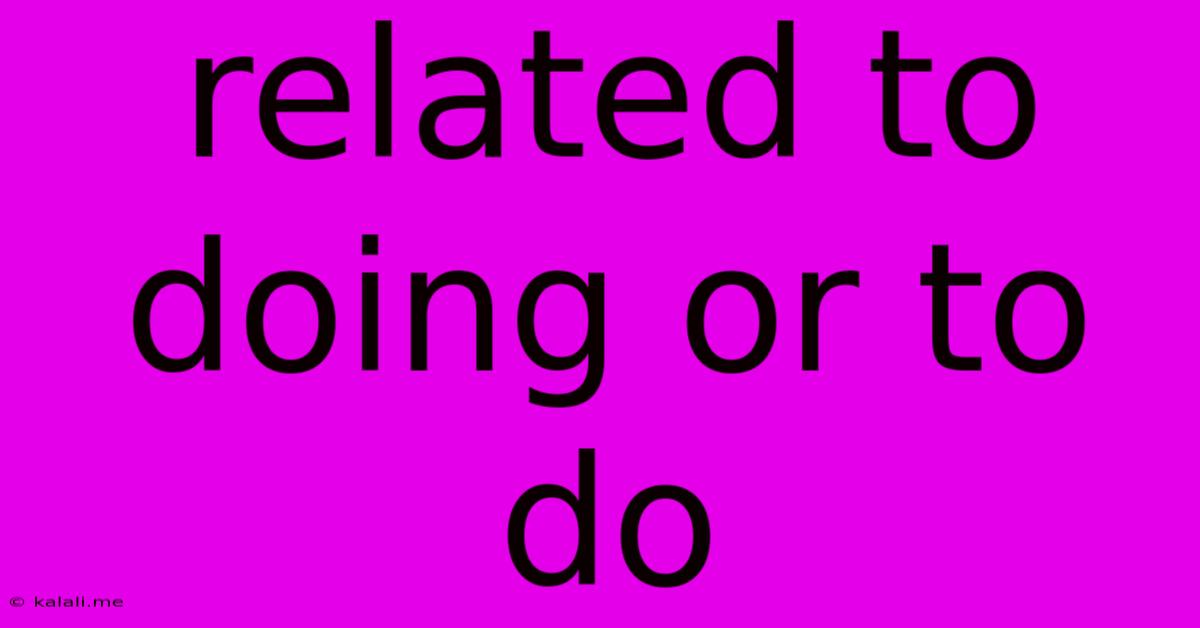Related To Doing Or To Do
Kalali
May 23, 2025 · 3 min read

Table of Contents
Doing vs. To Do: Understanding the Nuances of English Verbs
This article explores the subtle yet crucial differences between using "doing" and "to do" in English, focusing on their grammatical roles and contextual applications. Mastering these nuances will significantly enhance your writing clarity and precision. We'll cover various scenarios, providing clear examples to solidify your understanding. This guide is perfect for anyone looking to refine their English grammar skills, whether you're a student, writer, or simply someone who wants to communicate more effectively.
What's the Difference?
At first glance, "doing" and "to do" might seem interchangeable. However, they serve distinct grammatical functions:
-
"Doing" is the present participle of the verb "to do." It's used to form continuous tenses (present continuous, past continuous, future continuous) and also functions as a gerund (a verb acting as a noun).
-
"To do" is the base infinitive form of the verb. It's used to express purpose, obligation, or as part of various verb constructions.
Let's delve deeper into each usage:
Using "Doing"
-
Continuous Tenses: This is the most common use. "Doing" helps to describe actions in progress.
- Present Continuous: I am doing my homework.
- Past Continuous: She was doing the dishes when the phone rang.
- Future Continuous: They will be doing yoga tomorrow morning.
-
Gerunds: Here, "doing" acts as a noun. It's often preceded by a preposition.
- I enjoy doing puzzles.
- He's good at doing math.
- She's passionate about doing charity work.
Using "To Do"
-
Infinitives: This is the most basic form.
- I want to do my best.
- She needs to do better.
- They decided to do nothing.
-
Expressions of Purpose: Often paired with "in order to" or "so as to."
- He studied hard to do well on the exam.
- She woke up early in order to do some exercise.
-
Obligation or Necessity: Often used with modal verbs like "should," "must," "have to."
- You have to do your chores.
- We should try to do our best.
- I must do the laundry today.
-
Emphasizing Actions: Used for emphasis with verbs like "did" or "does."
- I did do my homework, I swear!
- She does do her best, even if it doesn't always show.
Common Mistakes and How to Avoid Them
One common mistake is confusing gerunds with infinitives. The correct choice depends on the verb and the context. For example:
- Correct: I enjoy doing yoga. (Gerund after "enjoy")
- Correct: I decided to do yoga this morning. (Infinitive after "decided")
Another common error is using "doing" when an infinitive is required, or vice versa. Careful consideration of the sentence structure and the intended meaning will help you avoid these errors.
Conclusion
Understanding the distinction between "doing" and "to do" is essential for clear and effective communication in English. By grasping their diverse grammatical functions and practicing their application, you can significantly improve your writing and speaking skills. Remember to consider the context and the verb they modify to ensure you're using the correct form. Continuous practice is key to mastering these nuances and achieving greater fluency in the English language.
Latest Posts
Latest Posts
-
How Long Is Gasoline Good For
May 23, 2025
-
Skyrim Getting Very High Vertical Momentum
May 23, 2025
-
How To Get File Info From Infohash
May 23, 2025
-
What Is A Solana Contract Address
May 23, 2025
-
How Long Does It Take To Preheat An Oven
May 23, 2025
Related Post
Thank you for visiting our website which covers about Related To Doing Or To Do . We hope the information provided has been useful to you. Feel free to contact us if you have any questions or need further assistance. See you next time and don't miss to bookmark.